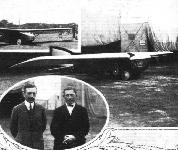
Описание
Страна : Бельгия
Год : 1921
Планер
Flight, August 1923
THE PONCELET LIGHT 'PLANE
IN our issue for July 12, we drew attention to "Some Climb," as credited by the lay press to Lieut. Simonet upon a 7 h.p. "motor-glider." Promptly M. Simonet from Brussels disowns the soft impeachment, and we are glad to say sends us not only the interesting facts, but also forwards a couple of photographs of his little 'plane, which we have much pleasure in reproducing. Lieut. Simonet's accompanying disclaimer and statement (which we were compelled to hold over) is as follows :-
"I have just read in your interesting paper your article ‘Some Climb’ regarding my performances on the Belgian glider 'Poncelet,' fitted with a 7-10 h.p. Anzani engine.
"I have not climbed at 2,600 ft. in one minute! It is, of course, a mistake on the part of the daily press. The truth is this :-
"Saturday, July 7, I tried for the first time the Poncelet light 'plane (tried before successfully as a glider). I flew 17 minutes at 100 to 200 metres; next day I flew 15 minutes; the Monday I flew 28 minutes and reached 800 metres. Tuesday I flew 45 minutes and reached easily (in about 20 minutes) a height of 1,100 metres. The machine is very well balanced, possesses a wide speed range (40 to 85 kilos.), lands at 35 kilos, per hour, and climbs at a rate of 60 to 75 m. per minute. The machine can be readily transformed to a pure glider by only removing engine and gasoline tank, which is placed behind pilot's head. The balance is exactly the same; this seems extraordinary as the pilot's seat is in front of the wing and the engine weighs 32 kgs. I propose, as you know already, to pilot this machine at the French gliding competition at Cherbourg. Another Belgian machine, the S.A.B.C.A. Jullien, fitted with a British Douglas five-over engine, will also take part in the competition.
"The 'Poncelet' light 'plane characteristics are as follows: span, 11 m. 20; length, 6 m. 70; weight: with engine, 100 kgs.; without engine, tank, etc., 155 kgs.; surface, 20 m.2; engine, 7-10 h.p. Anzani 1,100 c.c, developing 10 h.p. at max. revs. (1,550); petrol tank, 18 litres, oil tank, 3 litres, giving about 3 hours' flight duration. Wing: Gottingen section - deepest section, 38 mm."
The Poncelet Glider was illustrated in FLIGHT for March 1 last, and a comparison of this and the light plane is interesting.
Описание:
- Flight, August 1923
THE PONCELET LIGHT 'PLANE - Flight, August 1925
THE 1925 VAUVILLE MEETING
Фотографии
-
Flight 1923-03 / Flight
The Belgian Poncelet Glider, in flight and on the ground.
-
Flight 1923-08 / Flight
THE PONCELET LIGHT 'PLANE: At rest and in flight.
-
Flight 1923-10 / Flight
NO. 16, THE BELGIAN PONCELET LIGHT 'PLANE AT LYMPNE: Three-quarter front and rear views, and, below, the machine with wing stacked on top of the fuselage, ready for transport. The "Vivette," as No. 16 is called, is fitted with a four-cylinder Sergant engine.
-
Flight 1923-10 / Flight
Регистрационный номер: O-BAFG [2] The "Poncelet" at Lympne Lieut. Simonet in the cockpit of his machine "Castar." Inset, the machine in flight.
-
Flight 1923-12 / Flight
Регистрационный номер: O-BAFG [2] The King of the Belgians Inspecting Light 'Planes: Our photograph shows, left to right, Major Smeyers, Commander of the Belgian Air Force, King Albert, Lieut. Baron Kervyn de Lettenhove, Lieut. V. Simonet, and M. Poncelet, the designer of the light 'planes that took part in the Lympne competitions.
-
Flight 1925-08 / Flight
ONE OF TWO "RECORDMEN": The world's duration "record" holder, the Poncelet "Vivette," which has remained aloft for 10 hours 19 minutes 43 2/5 seconds. The inset shows M. Alfred Auger, left, pilot of the " Vautour," and Commandant Massaux, pilot of the "Vivette."
-
Flight 1923-10 / Flight
THE "VIVETTE" TURNS TURTLE: In starting for a flight at Lympne the Poncelet light 'plane "Vivette" was caught by a gust under one wing, with the result that she was blown on to one wing tip, buckled the port wheel, and turned over on her back. The pilot was unhurt. The larger photograph shows willing helpers carrying the machine back with her wheels uppermost, in the good old 1910-11 style. In the inset the machine is seen at the moment of striking.
-
Flight 1923-10 / Flight
LIGHT 'PLANES AT LYMPNE: Some constructional details. 6. In the Poncelet monoplanes the gap between aileron and rear wing spar is covered with a strip of celluloid.
-
Flight 1923-10 / Flight
LIGHT 'PLANES AT LYMPNE: A few interesting constructional features. 2, The petrol tank on the Poncelet monoplanes forms a fairing behind the pilot's head.
-
Flight 1923-10 / Flight
LIGHT 'PLANES AT LYMPNE: A few interesting constructional features. 3 shows the curious spur tail skid on the Poncelet;
- Фотографии









